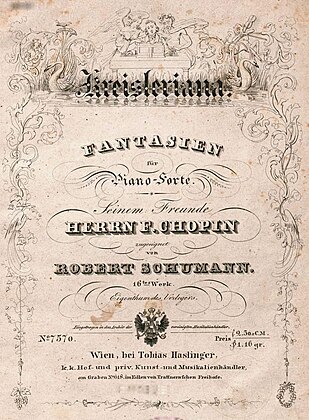
Back Kreisleriana German Kreisleriana Esperanto Kreisleriana Spanish Kreisleriana Finnish Kreisleriana (Robert Schumann) French Kreisleriana Italian クライスレリアーナ Japanese 크라이슬레리아나 Korean

Kreisleriana, Op. 16, is a composition in eight movements by Robert Schumann for solo piano, subtitled Phantasien für das Pianoforte. Schumann claimed to have written it in only four days in April 1838[1] and a revised version appeared in 1850. The work was dedicated to Frédéric Chopin, but when a copy was sent to the Polish composer, "he commented favorably only on the design of the title page".[2]
Kreisleriana is a very dramatic work and is viewed by some critics as one of Schumann's finest compositions.[3][4][5] In 1839, soon after publishing it, Schumann called it in a letter "my favourite work," remarking that "The title conveys nothing to any but Germans. Kreisler is one of E. T. A. Hoffmann's creations, an eccentric, wild, and witty conductor."[6] In 1843, when he had moved from writing for solo piano to much larger works, in particular Paradise and the Peri, he still listed it as one of his best piano works.[7]
The work's title was inspired by the character of Johannes Kreisler from works of E. T. A. Hoffmann.[8] Like the kaleidoscopic Kreisler, each number has multiple contrasting sections, resembling the imaginary musician's manic depression, and recalling Schumann's own "Florestan" and "Eusebius," the two characters Schumann used to indicate his own contrasting impulsive and dreamy sides. Johannes Kreisler appears in several books by Hoffmann, including Kater Murr and most notably in the Kreisleriana section of Fantasiestücke in Callots Manier, published in 1814.
In a letter to his wife Clara, Schumann reveals that she has figured largely in the composition of Kreisleriana:
I'm overflowing with music and beautiful melodies now – imagine, since my last letter I've finished another whole notebook of new pieces. I intend to call it Kreisleriana. You and one of your ideas play the main role in it, and I want to dedicate it to you – yes, to you and nobody else – and then you will smile so sweetly when you discover yourself in it.[9]
- ^ Eric Frederick Jensen states that it was composed between early May and mid-September 1838 – Schumann, Oxford University Press, 2001, p. 168 – but does not cite a reference.
- ^ Charles Rosen, The Romantic Generation, p. 284
- ^ Tommasini, Anthony (2018). The Indispensable Composers: A Personal Guide. Penguin. p. 237. ISBN 9781594205934.
- ^ James Leonard. Kreisleriana, 8 fantasies for piano, Op. 16 at AllMusic
- ^ Tibbetts, John C. (2010). Schumann: A Chorus of Voices. Hal Leonard. p. 197. ISBN 9781574671858.
- ^ Schumann, Robert (1907). Storck, Karl (ed.). The Letters of Robert Schumann. Translated by Bryant, Hannah. London: J. Murray. pp. 128.
- ^ Stork, Karl, ed., The Letters of Robert Schumann, London, 1907, pp. 126, 241.
- ^ Schumann, Robert (2004). Herttrich, Ernst (ed.). Kreisleriana (PDF) (in German). G. Henle Verlag. pp. III.
- ^ Carey, Norman, "An Improbable Intertwining: An Analysis of Schumann's Kreisleriana I and II, with Recommendations for Piano Practice," Theory and Practice, vol. 32 (2007), p. 23.
